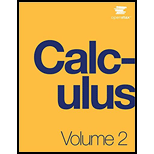
Laplace Transforms
In the last few chapters, we have looked at several ways to use
The Laplace transform is defined in terms of an integral as
7
e""
ft
Note that the input to a Laplace transform is a function of time, /(/), and the output is a function of frequency, F(j), Although many real-world examples require the use of
Let's stan with a simple example. Here we calculate the Laplace transform of /(f) = t. We have

This is an improper integral, so we express it in terms of a limit, which gives

Now we use integration by pans to evaluate the integral. Note that we are integrating with respect to t, so we treat the variable s as a constant. We have
u—t dv — dt
du=dt v
— — ye_ir.
Then we obtain
= + +
= ~K + °1 -
= JinL[[-i,-]-±[e--lj]
- c + c
= 0-0 + -L
s“
_x
2* s
1. Calculate the Laplace transform of /(/) = 1.
3.Calculate the Laplace transform of /(/) = : (Note, you will have to integrate by parts twice.)
Laplace transforms are often used to solve differential equations. Differential equations are not covered in detail until later in this book; but, for now, let’s look at the relationship between the Laplace transform of a function and the Laplace transform of its derivative.
Let’s start with the definition of the Laplace transform. We have
WW! = r™ r'
= lim / e~st fifth.
4.Use integration by parts to evaluate Jjm^ e~sl fifth. (Let « = /{/) and dv — e '!dt.) After integrating by parts and evaluating the limit, you should see that
Then,
Thus, differentiation in the time domain simplifies to multiplication by s in the frequency domain.
The final thing we look at in this project is how the Laplace transforms of fit] and its antiderivative are
related. Let g(r) — f(u}dii. Then,
¦'o
lim /
:-* caj" 5.Use integration by parts to evaluate hrn^y e ’ g(t)dl. (Let u = gif) and dv = e dt. Note, by the way,
that we have defined gif, du — fifth.)
As you might expect, you should see that
L|^(r)| = |-L[/(/)i.
Integration in the time domain simplifies to division by s in ±e frequency domain.
Want to see the full answer?
Check out a sample textbook solution
Chapter 3 Solutions
Calculus Volume 2
Additional Math Textbook Solutions
Calculus Volume 1
Introductory Statistics
Mathematics All Around (6th Edition)
Finite Mathematics for Business, Economics, Life Sciences and Social Sciences
Using and Understanding Mathematics: A Quantitative Reasoning Approach (6th Edition)
Finite Mathematics & Its Applications (12th Edition)
- Algebra & Trigonometry with Analytic GeometryAlgebraISBN:9781133382119Author:SwokowskiPublisher:Cengage
